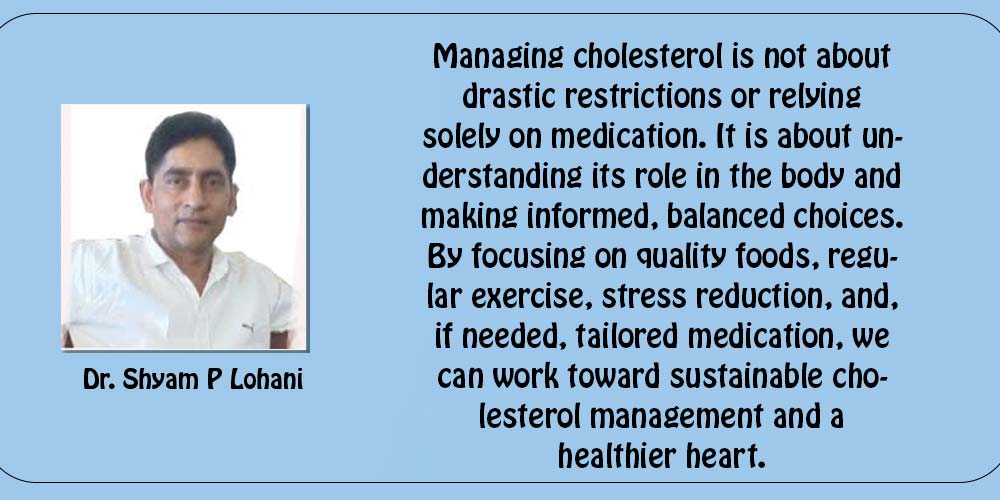- Friday, 7 November 2025
Approaches To Healthier Heart
Cholesterol often gets a bad reputation, frequently labeled as a leading cause of heart disease and other cardiovascular issues. We have heard it in medical warnings, dietary advice, and the near-ubiquitous guidance to lower our cholesterol intake. But does this tell the whole story, or are we missing the broader role cholesterol plays in our bodies?
Managing cholesterol is often portrayed as a simple lowering it in blood. However, role of cholesterol in our health is complex, requiring a more balanced and comprehensive approach. Lowering cholesterol is not just about cutting out foods, but about lifestyle choices, understanding its different types, and, if necessary, integrating medication wisely if necessary.
Roles
Cholesterol is an essential fat-like substance produced by our liver and also absorbed from the foods we eat. It is a structural component of every cell membrane in our body, necessary for producing certain hormones, vitamin D, and bile acids that help digest fat. Without it, our bodies could not function properly. However, its role in heart disease has created an intense focus on lowering cholesterol, often through lifestyle changes or medications. Not all cholesterol is bad. The body naturally produces cholesterol, and only about 20-30 per cent comes from food.
This means that while diet is important, there are other factors, such as genetics, lifestyle, and medication that play critical roles. This dual nature makes cholesterol a unique part of our diet and health as both a friend and a potential foe. The popular view often reduces cholesterol to two types as bad LDL (Low-Density Lipoprotein) and good HDL (High-Density Lipoprotein). While it is true that higher LDL levels can contribute to plaque buildup in arteries (atherosclerosis), which raises heart disease risk, not all LDL cholesterol behaves the same. Large, buoyant LDL particles, for example, are less likely to cause harm than small, dense LDL particles.
The key lies in managing the balance of HDL (High-Density Lipoprotein, the good cholesterol) and LDL (Low-Density Lipoprotein, the bad cholesterol). HDL works to carry cholesterol out of the bloodstream and back to the liver for processing, while LDL, in excess, can contribute to plaque buildup in arteries. It is also essential to recognise that LDL comes in various forms, with small, dense particles being the most harmful. Managing cholesterol means looking at these broader measures instead of one single number. Higher HDL levels are generally thought to protect against heart disease, but recent studies suggest that too much HDL might also pose risks, complicating the good versus bad narrative.
Diet and Lifestyle
Diet undeniably influences cholesterol levels, but perhaps not as simply as we once believed. While saturated fats were long deemed the primary culprit, recent research indicates that refined carbohydrates and sugars may have an even greater impact on harmful cholesterol levels. Furthermore, high-intensity, low-carbohydrate diets (like keto) can sometimes raise HDL and shift LDL to a safer profile, leading to a reassessment of dietary guidance.
Traditional advice often focused on avoiding high-cholesterol foods, but we now know that dietary cholesterol has less impact on blood cholesterol than saturated and trans fats do. Instead of removing fats altogether, include unsaturated fats from sources like olive oil, avocados, and nuts, which may help lower LDL levels. These fats, found in processed foods, fried foods, and fatty cuts of meat, can raise LDL cholesterol. Aiming to limit these fats can positively impact cholesterol levels. Soluble fibre found in oats, fruits, vegetables, and legumes can help reduce cholesterol by binding it in the digestive system. It is suggested to incorporate fibre-rich foods daily.
Beyond food, physical activity and mental stress play significant roles. Regular exercise raises HDL levels and can improve LDL particle size, while chronic stress may increase cholesterol as the body produces more in response to hormonal shifts. Regular physical activity can increase HDL levels and improve overall heart health. Exercise also helps maintain a healthy weight, which can lower LDL levels. Engaging in moderate to high-intensity workouts, such as brisk walking, cycling, or swimming, for at least 150 minutes per week can make a significant difference. Even small changes, like taking the stairs or walking instead of driving short distances, can contribute to better cholesterol management.
Chronic stress
Chronic stress can raise cholesterol levels by increasing inflammation and altering metabolism. Practicing mindfulness, deep breathing exercises, or engaging in hobbies can help reduce stress levels. Similarly, lack of sleep disrupts the body’s balance, which can lead to higher cholesterol and weight gain. Prioritising a regular sleep schedule is essential for heart health.
Managing cholesterol is not about drastic restrictions or relying solely on medication. It is about understanding its role in the body and making informed, balanced choices. By focusing on quality foods, regular exercise, stress reduction, and, if needed, tailored medication, we can work toward sustainable cholesterol management and a healthier heart. This approach is both empowering and effective, offering a path to cardiovascular health that fits into a well-rounded lifestyle.
(Dr. Lohani is the executive director at the Health Concern. lohanis@gmail.com)
















